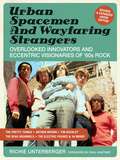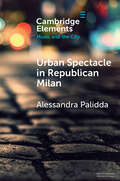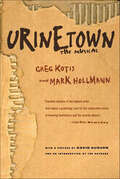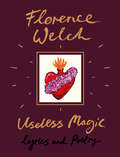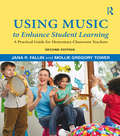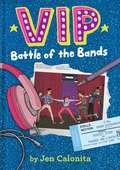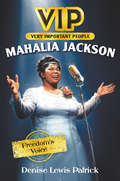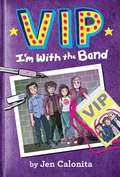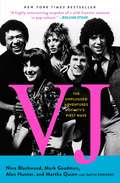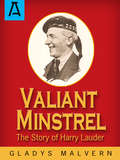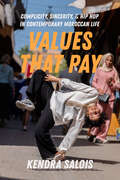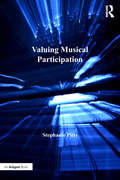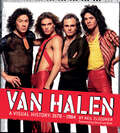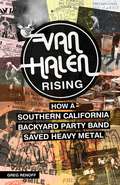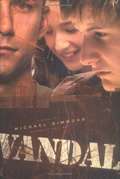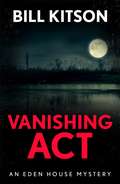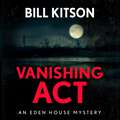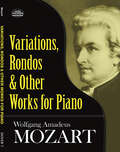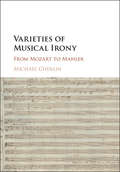- Table View
- List View
Urban Spacemen and Wayfaring Strangers
by Richie Unterberger"Urban Spacemen & Wayfaring Strangers: Overlooked Innovators & Eccentric Visionaries of '60s Rock" documents twenty cult rockers from the 1960s. The book features extremely detailed investigation of the careers of greats like the Pretty Things, Arthur Brown, Richard & Mimi Fariña, and Tim Buckley. Also featured are the Bonzo Dog Band, the Electric Prunes, Bobby Fuller, the Fugs, Kaleidoscope, Fred Neil, the Beau Brummels, Thee Midniters, Dino Valenti, Mike Brown of the Left Banke, and others, including producers Shel Talmy (the Who, the Kinks, Pentangle) and Giorgio Gomelsky (the Yardbirds, Julie Driscoll, the Soft Machine). In all cases, the extensive chapters include first-hand interview material with the artists themselves and/or their close associates. Lost British Invaders, psychedelic pioneers, rock funnymen, blue-eyed soulsters, overlooked folk-rockers, behind-the-scenes producers -- all find a home as part of "Urban Spacemen & Wayfaring Strangers," with a foreword by Paul Kantner of Jefferson Airplane. The ebook version of "Urban Spacemen & Wayfaring Strangers" is significantly expanded, revised, and updated from the print version, adding 20,000 words of new material. The text is accompanied by illustrations and reviews of the most essential recordings by each artist. From reviews of "Urban Spacemen":"[He] brings to this volume a true fan's love of music combined with a writer's smarts and skills. He seamlessly combines researched material with new interviews. . . Not only did Unterberger choose well musically, but he found the momentum and heart of each of their stories. " -- David Greenberger (essayist on National Public Radio's "All Things Considered"), Pulse!"These fascinating tales will make you want to rush out to the record store -- a hallmark of all great music writing. " -- Jim DeRogatis, Chicago Sun-Times"In each fascinating case study the author tracks down one or more former group members and/or principals in the story, which gives his work both authority and freshness. . . his overall handling of the material is exemplary. "Urban Spacemen" forms a compelling mosaic of the hopes and dreams -- not to mention sharp business practices -- of the decade. " -- Mike Barnes (author of the biography "Captain Beefheart"), The Wire
Urban Spectacle in Republican Milan: Pubbliche feste at the Turn of the Nineteenth Century (Elements in Music and the City)
by Alessandra PaliddaAt the turn of the nineteenth century, Lombardy and its capital Milan lived through a season of intense social and political change, especially in the passage between Austrian Monarchy and Napoleonic republics (1796-1799, and 1800-1802). While affecting cultural production on all levels, this passage occasioned a significant change in terms of public celebration, with republican festivals and other celebratory occasions coming from revolutionary France being reframed amongst Milanese specificities. After establishing a solid historical and aesthetic background to Lombardy in this delicate period, to the revolutionary models and to the Milanese substrate, this Element aims at reconstructing and describing the main features of the French republican festivals in Milan, and their impact on the city's landscape, soundscape and self-representation. It will also conclude by offering some reflections on these events' consequences on the following century's patriotism/nationalism and cultural production, reinstating them as an interesting, albeit forgotten case study.
Urinetown: The Musical
by Greg Kotis Mark HollmannWinner of three Tony Awards, including Best Book, Greg Kotis and Mark Hollmann's Urinetown: The Musical is a tale of greed, corruption, love, and revolution in a time when water is worth its weight in gold.After a twenty-year drought made water a scarce commodity, private toilets became outlawed. Now, all restroom necessaries are controlled by the Urine Good Company (UGC), a megacorporation that charges fees for using public toilets. Anyone unable to pay fees--or who dares to relieve themselves outside the commode--are arrested and banished to "Urinetown".When UGC employee Bobby Strong's father falls victim to this tyranny, he spearheads a revolution, inspiring the people to rise up and reclaim their own restroom duties--unaware of the realities and consequences of his actions...With a preface by David Auburn, Pulitzer Prize-winning playwright of ProofAnd an introduction by the authors
Useless Magic: Lyrics and Poetry
by Florence WelchLyrics and never-before-seen poetry and sketches from the iconic musician of Florence and the MachineSongs can be incredibly prophetic, like subconscious warnings or messages to myself, but I often don't know what I'm trying to say till years later. Or a prediction comes true and I couldn't do anything to stop it, so it seems like a kind of useless magic.
Usher (Superstars of Hip-Hop)
by Z. B. HillUsher is one of music's biggest stars. He's won awards and sold millions of albums. Not only is he working on his own music, but he's also bringing other artists to the world. Usher made Justin Bieber a star after seeing the young singer on YouTube. Usher's such a big star he can make others famous! Usher tells the story of how Usher became the star fans know today. Read about how Usher went from singing in church to singing at sold-out shows. Learn about how Usher has found success in music and acting.
Using Music to Enhance Student Learning: A Practical Guide for Elementary Classroom Teachers
by Mollie Gregory Tower Jana R. Fallin Debbie TannertUsing Music to Enhance Student Learning: A Practical Guide for Elementary Classroom Teachers, Third Edition, provides Elementary Education students with the tools and pedagogical skills they need to integrate music into the general education classroom setting. The goal of this interdisciplinary approach is to increase student engagement in Language Arts, Math, Science, and Social Studies—with minimal music theory involved—while stimulating social and emotional development. Supported by current research in an ever-changing field, the strategies and methods collected here are suitable for pre- and in-service teachers alike, highlighting intuitive musical pathways that are effective in maintaining a student’s attention, building motivation, and enhancing learning in all subjects. New to this edition: A new chapter—"The Brain Connection"—detailing music’s impact on learning Updated listening maps, unique to Using Music to Enhance Student Learning and its teaching method A revised and comprehensive songbook as an appendix—no longer a separate booklet Updated listening examples to reflect diverse populations Modified references throughout to account for recent research A robust companion website features full-color animated listening maps, streaming audio tracks, sample syllabi and quizzes, assignment rubrics, links for additional resources, and more. Ideal for promoting learning experiences in both music and general classroom subjects, Using Music to Enhance Student Learning presents musical integration strategies that are practical, efficient, and easy to infuse into standard curricula.
Using Music to Enhance Student Learning: A Practical Guide for Elementary Classroom Teachers
by Jana Fallin Mollie Gregory TowerIntegrating musical activities in the elementary school classroom can assist in effectively teaching and engaging students in Language Arts, Science, Math, and Social Studies, while also boosting mental, emotional and social development. However, many elementary education majors fear they lack the needed musical skills to use music successfully. Future elementary school teachers need usable, practical musical strategies to easily infuse into their curriculum. Written for both current and future teachers with little or no previous experience in music, Using Music to Enhance Student Learning, 2nd Edition offers strategies that are not heavily dependent on musical skills. While many textbooks are devoted to teaching music theory skills, this textbook is dedicated to pedagogy – the actual teaching of music – particularly in those schools without a separate music class in their curriculum. The ultimate goal is for future teachers to provide their elementary school classes with engaging learning experiences. These learning experiences are clearly presented to enable children to acquire knowledge in all subject areas within a joyful, creative environment rich with music activities. New to the second edition are the animated listening maps, more audio tracks, a new guitar unit, expanded coverage in the recorder unit, a connection with visual art and music, expanded activities in American history and math, and updated research and statistics. SPECIAL FEATURES Animated "Listening Maps" help listeners focus on music selections through clear visual representations of sound. Group Activities reinforce the social aspects of music-making, as well as the benefits of collaborative teaching and learning. A thorough integration of music in the curriculum establishes that music is essential in a child’s development, and that the incorporation of music will enhance all other subjects/activities in the classroom. Learning Aids include "Tantalizing Tidbits of Research," which provide the justifications for why these activities are important, as well as "Teaching Tips," and "Thinking It Through" activities. The Using Music Package Streamed listening selections from the Baroque, Classical, Romantic, and Contemporary Periods Get America Singing…Again! Volume 1 (developed in association with the Music Educators National Conference, now NAFME, and other music organizations) with 43 songs that represent America’s varied music heritage of folk, traditional, and patriotic themes Appendices include a songbook with Hispanic folksongs, a recorder music songbook and a guitar unit Companion website hosts various teaching and learning resources
Using Music to Enhance Student Learning: A Practical Guide for Elementary Classroom Teachers
by Mollie Gregory Tower Jana R. FallinIntegrating musical activities in the elementary school classroom can assist in effectively teaching and engaging students in Language Arts, Science, Math, and Social Studies, while also boosting mental, emotional and social development. However, many elementary education majors fear they lack the needed musical skills to use music successfully. Future elementary school teachers need usable, practical musical strategies to easily infuse into their curriculum. Written for both current and future teachers with little or no previous experience in music, Using Music to Enhance Student Learning, Second Edition offers strategies that are not heavily dependent on musical skills. While many textbooks are devoted to teaching music theory skills, this textbook is dedicated to pedagogy – the actual teaching of music – particularly in those schools without a separate music class in their curriculum. The ultimate goal is for future teachers to provide their elementary school classes with engaging learning experiences. These learning experiences are clearly presented to enable children to acquire knowledge in all subject areas within a joyful, creative environment rich with music activities. New to the second edition are the animated listening maps, more audio tracks, a new guitar unit, expanded coverage in the recorder unit, a connection with visual art and music, expanded activities in American history and math, and updated research and statistics. SPECIAL FEATURES Animated "Listening Maps" help listeners focus on music selections through clear visual representations of sound. Group Activities reinforce the social aspects of music-making, as well as the benefits of collaborative teaching and learning. A thorough integration of music in the curriculum establishes that music is essential in a child’s development, and that the incorporation of music will enhance all other subjects/activities in the classroom. Learning Aids include "Tantalizing Tidbits of Research," which provide the justifications for why these activities are important, as well as "Teaching Tips," and "Thinking It Through" activities. The Using Music Package Streamed listening selections from the Baroque, Classical, Romantic, and Contemporary Periods Get America Singing… Again! Volume 1 (developed in association with the Music Educators National Conference, now NAFME, and other music organizations) with 43 songs that represent America’s varied music heritage of folk, traditional, and patriotic themes Appendices include a songbook with Hispanic folksongs, a recorder music songbook and a guitar unit Companion website hosts various teaching and learning resources ISBN 978-0-367-11067-3 Using Music, Second Edition set includes: ISBN 978-0-415-70936-1 Using Music, Second Edition textbook Get America Singing... Again! Volume 1 songbook ISBN 978-0-429-02487-0 Using Music, Second Edition eBook is the textbok only. The songbook is only available with the print textbook and is not sold separately.
VIP: Battle of the Bands (VIP #2)
by Jen Calonita Kristen GudsnukMackenzie "Mac" Lowell is living a dream come true on tour with her favorite boy band. Spending time on the road with Perfect Storm hasn't been what Mac expected, though-it's even BETTER! But with screaming fans and big-time recording sessions come haters and copycats, like Thunder and Lightning, a new band on the label whose first single sounds suspiciously like the song Perfect Storm's guitarist wrote for Mac. As the two bands set out on a joint summer tour, more and more of Perfect Storm's secrets are leaked to the public.Where's the one place all these lyrics and secrets are supposedly being kept safe? In Mac's journal, of course! Can Mac-and her comic-book alter ego, Mac Attack-stop the leaks and nab the culprit?With black-and-white illustrations and action-packed Mac Attack comics throughout, Jen Calonita's VIP series is more exciting than a backstage pass!
VIP: Freedom's Voice (VIP #3)
by Denise Lewis PatrickGet ready to sing for justice with Mahalia Jackson in this exciting middle grade nonfiction biography. Perfect for fans of the Who Was and Little Leaders series, the books in the VIP series tell the true—and amazing—stories of some of history's greatest trailblazers. Meet the VERY IMPORTANT PEOPLE who changed the world! Mahalia Jackson was known as the queen of gospel music. A close friend of Dr. Martin Luther King Jr.’s, she was also a civil rights activist who sang at the March on Washington. And she traveled the world, too! Experience all the inspiring moments in Mahalia’s big life in this thrilling biography, packed with two-color illustrations and fun facts, like who invented rock and roll! Short and engaging chapters are interspersed with special lists and other information made to order to engage kids, whether they're already biography fans or "have to" write a report for school. Extras include a timeline, a bibliography, and a hall of fame of other musicians and civil rights activists. The VIP series features stirring adventures and fun facts about some of history's greatest trailblazers—smart, tough, persevering innovators who will excite today's kids. Featuring underappreciated historical figures and groups, with a focus on leaders in science, activism, and the arts, the nonfiction biographies in the VIP series are fun and appealing. Just looking at the cover will make kids want to learn more about these VIPs, and once they dive in they will zoom through stories that read like adventures. Each book in the VIP series allows your middle grader to experience all the fascinating moments in some very important but lesser known lives. These biographies for kids age 9-12 include: VIP: Dr. Mae Jemison: Brave Rocketeer; VIP: Lewis Latimer: Engineering Wizard; VIP: Mahalia Jackson: Freedom's Voice; and VIP: Lydia Darragh: Unexpected Spy.
VIP: I'm With the Band (VIP #1)
by Jen Calonita Kristen GudsnukTwelve-year-old Mackenzie "Mac" Lowell's dreams have come true. Thanks to her mom scoring the coolest job EVER, Mac is going from boy band fanatic to official tour member of her favorite group, Perfect Storm. Good thing she's brought along her journal so she can record every moment, every breath, and every one of lead singer Zander Welling's killer smiles in written detail and daydreamy doodles.But between a zillion tour stops and pranks gone wrong, Zander and his fellow band members, Heath Holland and Kyle Beyer, become more like brothers to Mac. When the boys' differences start to drive them apart, can Perfect Storm's biggest fan remind them why they'reperfect together? It'll be up to Mac--and her comic-book alter ego, Mac Attack--to keep the band together and on the road to stardom Chronicling her experiences on tour, Mac's journal springs to life with black-and-white illustrations and comic-book panels throughout its pages.
VJ
by Gavin Edwards Mark Goodman Nina Blackwood Martha Quinn Alan HunterThe original MTV VJs offer a behind-the-scenes oral history of the early years of MTV, circa 1981 to 1985, when it was exploding, reshaping the culture, and forming "the MTV generation."MTV's first VJs (along with the late J.J. Jackson) had front-row seats to a cultural revolution--and the hijinks of rock stars from Adam Ant to Cyndi Lauper. Their worlds collided, of course: John Cougar invited Nina Blackwood to a late night "party" that proved to be a seduction attempt. Mark Goodman partied with David Lee Roth, who offered him cocaine and groupies. Aretha Franklin made chili for Alan Hunter. After Martha Quinn interviewed Bob Dylan, he whisked her off to Ireland in his private jet. While the book has plenty of dish--secret romances, nude photographs, incoherent celebrities--it also tells the story of four VJs growing up alongside MTV's devoted viewers. Using MTV as a focal point, the book tells the story of the 1980s, from the neon-colored drawstring pants to the Reagan administration. Readers don't just get the inside scoop on music stars like Bob Dylan, Madonna, and Duran Duran, but a deeper understanding of how MTV changed our culture. Or as the VJs put it: "We're the reason you have no attention span."
Valiant Minstrel: The Story of Harry Lauder
by Gladys MalvernThe winner of the 1943 Julia Ellsworth Ford Foundation Award, Valiant Minstrel tells the life story of beloved Scottish entertainer Harry Lauder, presented as a biographical novel. Gladys Malvern's intimate account of Lauder's humble beginnings in mills and coalmines and incredible thirty-year career, which saw him knighted, makes it clear why he was the highest paid theatrical performer of his time. Malvern uses her gift for enthralling prose to recreate Lauder's experiences in this page-turner, available for the first time in ebook.
Values That Pay: Complicity, Sincerity, and Hip Hop in Contemporary Moroccan Life (California Series in Hip Hop Studies)
by Kendra SaloisA free ebook version of this title is available through Luminos, University of California Press’s Open Access publishing program. Visit www.luminosoa.org to learn more. Today, Morocco's hip hop artists are vital to their country's reputation as diverse, creative, and modern. But in the 1990s and 2000s, teenage amateurs shaped their craft and ideals together as the profound socioeconomic changes of neoliberalization swept through their neighborhoods. Values That Pay traces Moroccan hip hop's trajectory from sidewalk cyphers and bedroom studios to royal commendations and international festivals. Kendra Salois draws from more than ten years of research into her interlocutors' music and moral reasoning to explore the constitutive tensions of institutionalization, hip hop aesthetics, and neoliberal life. Entrepreneurial artists respond to their unavoidable complicity with an extractive state through aesthetic and interpersonal sincerity, educating their fans on the risks and responsibilities of contemporary citizenship. Salois argues that over the past forty years, Moroccan hip hop practitioners have transformed not only themselves but also what it means to be an ethical citizen in a deeply unequal nation.
Valuing Musical Participation
by Stephanie PittsIncreasingly, it is becoming evident that those involved in socio-musical studies must focus their investigative lens on musical practice and articulation of the self, on music and community involvement and on music as a social medium for social relationships. What motivates people to be involved in musical performance, and how do they articulate these needs and drives? What do performers gain from their involvement in musical activities? How do audience members perceive their relationship to the performer, the music and the event? These questions and many more are addressed here with the benefit of detailed empirical work, including case studies of a chamber music festival and a contemporary music summer school. Pitts investigates the value of musical participation for performers and audience members in a range of contexts, using a multi-disciplinary approach to place new empirical data in the framework of existing theory and literature. Themes examined include: the shared musical experience; the social structures of performing societies; how people identify with music; the values implicit in musical preferences; the social responsibilities of the performer; the audience view of concerts and festivals; the social power of music and educational implications and responsibilities. Pitts draws upon literature from musicology, sociology and psychology of music, ethnomusicology, music education and community music to demonstrate the diversity of enquiry about musical behaviours. The conclusions of the book are based upon empirical evidence gleaned through case studies, with the data integrated thematically throughout, to enable a greater depth of discussion than individual studies usually permit.
Valuing Nineteenth-Century Italian Opera Fantasias for Woodwind Instruments: Trash Music (Routledge Research in Music)
by Rachel N. BeckerThis book approaches opera fantasias – instrumental works that use themes from a single opera as the body of their virtuosic and flamboyant material – both historically and theoretically, concentrating on compositions for and by woodwind-instrument performers in Italy in the nineteenth century.Important overlapping strands include the concept of virtuosity and its gradual demonization, the strong gendered overtones of individual woodwind instruments and of virtuosity, the distinct Italian context of these fantasias, the presentation and alteration of opera narratives in opera fantasias, and the technical and social development of woodwind instruments. Like opera itself, the opera fantasia is a popular art form, stylistically predictable yet formally flexible, based heavily on past operatic tradition and prefabricated materials. Through archival research in Italy, theoretical analysis, and exploration of European cultural contexts, this book clarifies a genre that has been consciously stifled and societal resonances that still impact music reception and performance today.
Van Halen
by Neil Zlozower David Lee RothFrom their eponymous 1978 debut through their colossal 1984 album (they've sold over 75 million albums worldwide), Van Halen rewrote all the rules. Nobody rockedor partiedharder. Photographer Neil Zlozower first met the band in 1978, worked with them again on Van Halen II, and soon became their friend, hanging out in L.A. and hitting the road on tour with them. Van Halen collects more than 250 backstage, candid, and full rock-out photos of the all-powerful, spandexed, high-kicking, guitar blazing, stadium-shaking, original Van Halen lineup. Accompanying Zlozower's amazing photos are an introduction about his wild ride with VH, a foreword by David Lee Roth, and testimony from the rock pantheon paying homage to the band, including members of Led Zeppelin, Guns N' Roses, Def Leppard, Judas Priest, KISS, Motley Cre, and more. Turn it up!
Van Halen Rising: How a Southern California Backyard Party Band Saved Heavy Metal
by Greg RenoffAfter years of gigging everywhere from suburban backyards to dive bars, Van Halen - led by frontman extraordinaire David Lee Roth and guitar virtuoso Edward Van Halen - had the songs, the swagger and the talent to turn the rock world on its ear. The quartet's classic 1978 debut, Van Halen, sold more than a million copies within months of release and sky-rocketed the band to the stratosphere of rock success. Their high-energy shows left fans and bands alike floored. Based on more than 230 original interviews, Van Halen Rising tells of the band's electric rise to fame.
Vandal
by Michael SimmonsThe love-hate relationship between high school musician Will and his older brother Jason is fueled by the abuse Will suffers at Jason's hands but a devastating accident changes everything for the boys and their family.
Vanishing Act: The third book in a suspenseful and chilling mystery series (The Eden House Mysteries, Book Three) (The Eden House Mysteries #3)
by Bill Kitson'Reading this book for the second time' ***** Reader Review1965 - the heyday of Rock & Roll. Northern Lights are tipped to become as big as The Beatles. But after a gig in Newcastle, lead singer and creative genius, Gerry Crowther, vanishes into the foggy night. Later, his body is recovered from the River Tyne. Now, almost twenty years on, teen singing sensation Trudi Bell dominates the charts. As she prepares to release a new album, her manager Lew Pattison receives a demo tape from an unknown songwriter. Realising the music is unmistakeably the work of Gerry Crowther, Lew enlists the help of Adam and Eve to uncover the truth. But some people will stop at nothing to keep it buried . . .Vanishing Act is the third instalment in Bill Kitson's chilling and suspenseful Eden House mystery series. Perfect for fans of Peter James's Cold Hill series, Val McDermid and J M Dalgliesh.Readers are hooked on The Eden House Mysteries:'I couldn't sleep until I had finished this book' ***** Reader Review'The best book I have read in a while' ***** Reader Review'Captivating from start to finish. Brilliant page turner. I couldn't put it down' ***** Reader Review'Read the whole thing in a day' ***** Reader Review'One of the best authors I have come across' ***** Reader Review'More twists than a corkscrew' ***** Reader Review'The characters are brilliant and the story keeps you on the edge of your seat the whole time. Would highly recommend this book!' ***** Reader Review
Vanishing Act: The third book in a suspenseful and chilling mystery series (The Eden House Mysteries, Book Three) (The Eden House Mysteries #3)
by Bill Kitson'Reading this book for the second time' ***** Reader Review1965 - the heyday of Rock & Roll. Northern Lights are tipped to become as big as The Beatles. But after a gig in Newcastle, lead singer and creative genius, Gerry Crowther, vanishes into the foggy night. Later, his body is recovered from the River Tyne. Now, almost twenty years on, teen singing sensation Trudi Bell dominates the charts. As she prepares to release a new album, her manager Lew Pattison receives a demo tape from an unknown songwriter. Realising the music is unmistakeably the work of Gerry Crowther, Lew enlists the help of Adam and Eve to uncover the truth. But some people will stop at nothing to keep it buried . . .Vanishing Act is the third instalment in Bill Kitson's chilling and suspenseful Eden House mystery series. Perfect for fans of Peter James's Cold Hill series, Val McDermid and J M Dalgliesh.Readers are hooked on The Eden House Mysteries:'I couldn't sleep until I had finished this book' ***** Reader Review'The best book I have read in a while' ***** Reader Review'Captivating from start to finish. Brilliant page turner. I couldn't put it down' ***** Reader Review'Read the whole thing in a day' ***** Reader Review'One of the best authors I have come across' ***** Reader Review'More twists than a corkscrew' ***** Reader Review'The characters are brilliant and the story keeps you on the edge of your seat the whole time. Would highly recommendthis book!' ***** Reader Review(P) 2021 Headline Publishing Group Ltd
Vanishing Act: The third book in a suspenseful and chilling mystery series (The Eden House Mysteries, Book Three) (The\eden House Mysteries Ser. #3)
by Bill Kitson'Reading this book for the second time' ***** Reader Review1965 - the heyday of Rock & Roll. Northern Lights are tipped to become as big as The Beatles. But after a gig in Newcastle, lead singer and creative genius, Gerry Crowther, vanishes into the foggy night. Later, his body is recovered from the River Tyne. Now, almost twenty years on, teen singing sensation Trudi Bell dominates the charts. As she prepares to release a new album, her manager Lew Pattison receives a demo tape from an unknown songwriter. Realising the music is unmistakeably the work of Gerry Crowther, Lew enlists the help of Adam and Eve to uncover the truth. But some people will stop at nothing to keep it buried . . .Vanishing Act is the third instalment in Bill Kitson's chilling and suspenseful Eden House mystery series. Perfect for fans of Peter James's Cold Hill series, Val McDermid and J M Dalgliesh.Readers are hooked on The Eden House Mysteries:'I couldn't sleep until I had finished this book' ***** Reader Review'The best book I have read in a while' ***** Reader Review'Captivating from start to finish. Brilliant page turner. I couldn't put it down' ***** Reader Review'Read the whole thing in a day' ***** Reader Review'One of the best authors I have come across' ***** Reader Review'More twists than a corkscrew' ***** Reader Review'The characters are brilliant and the story keeps you on the edge of your seat the whole time. Would highly recommend this book!' ***** Reader Review
Variations and Variation Technique in the Music of Chopin
by Zofia ChechlińskaWhile Chopin composed only a few works in variation form, he employed variations and variation technique in the majority of his works. Multiple modified repetitions of musical units on different levels of a work are so typical of Chopin’s works that this may be considered one of the chief determinants of his style. Focusing on a broad range of Chopin’s works, this book explores the extent to which Chopin’s oeuvre is suffused with variations, the role that variation technique plays in his work, to what extent it interacts with other techniques for developing and modifying musical material, and how the variation technique itself evolved. Beginning with a comprehensively documented investigation of the concept of variation in its own right, Zofia Chechlińska employs Riemannian and Schenkerian theory to consider, in turn, the ways in which Chopin constructs variations on the level of microstructure (motif and phrase) and macrostructure (thematic areas, sections, movements and form). This is the first English translation of one of the classics of musicological literature in Poland and is essential reading for scholars of Chopin and nineteenth-century music and music analysts.
Variations, Rondos and Other Works for Piano
by Wolfgang Amadeus MozartThe elegance, grace, and clarity of Mozart's piano music has charmed generations of music lovers. Now 37 of the composer's delightful piano pieces have been collected in this attractive volume, reproduced from the authoritative Breitkopf & Härtel edition. Among the selections are:Variations on "Mio caro Andone" by Salieri, K.180/173cVariations on "Je suis Lindor" by Baudron, K. 354/299aVariations on "Ah vous dirai-je, maman," K. 265/300eVariations on "La belle françoise," K.353/300fVariations on "Salve tu, Domine" by Paisiello, K. 398/416eVariations on "Unser dummer Pöbel meint" by Gluck, K.455 Variations on a Minuet by Duport, K.573Rondo in D Major, K.485Rondo in A Minor, K.511Minuet in G Major, K.1/1eMinuet in F Major, K.2Minuet in D Major, K.355/576bAllegro in B-flat Major, K.3Allegro in B-flat Major, K.400/372aAllegro in G Minor, K.312/590dFugue in G Minor, K.401/3753Fugue in E-flat Major, K.153/375fFugue in G Minor, K.154/385kCapriccio in C Major, K.395/300gAllegro and Andante, K.533Adagio in B Minor, K.540Gigue in G Major, K.574... and more.
Varieties of Musical Irony: From Mozart to Mahler
by Michael CherlinIrony, one of the most basic, pervasive, and variegated of rhetorical tropes, is as fundamental to musical thought as it is to poetry, prose, and spoken language. In this wide-ranging study of musical irony, Michael Cherlin draws upon the rich history of irony as developed by rhetoricians, philosophers, literary scholars, poets, and novelists. With occasional reflections on film music and other contemporary works, the principal focus of the book is classical music, both instrumental and vocal, ranging from Mozart to Mahler. The result is a surprising array of approaches toward the making and interpretation of irony in music. Including nearly ninety musical examples, the book is clearly structured and engagingly written. This interdisciplinary volume will appeal to those interested in the relationship between music and literature as well as to scholars of musical composition, technique, and style.
